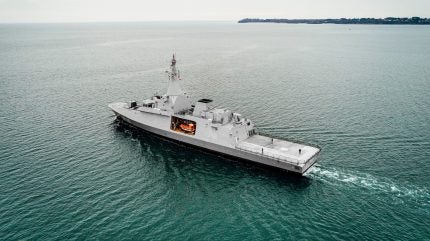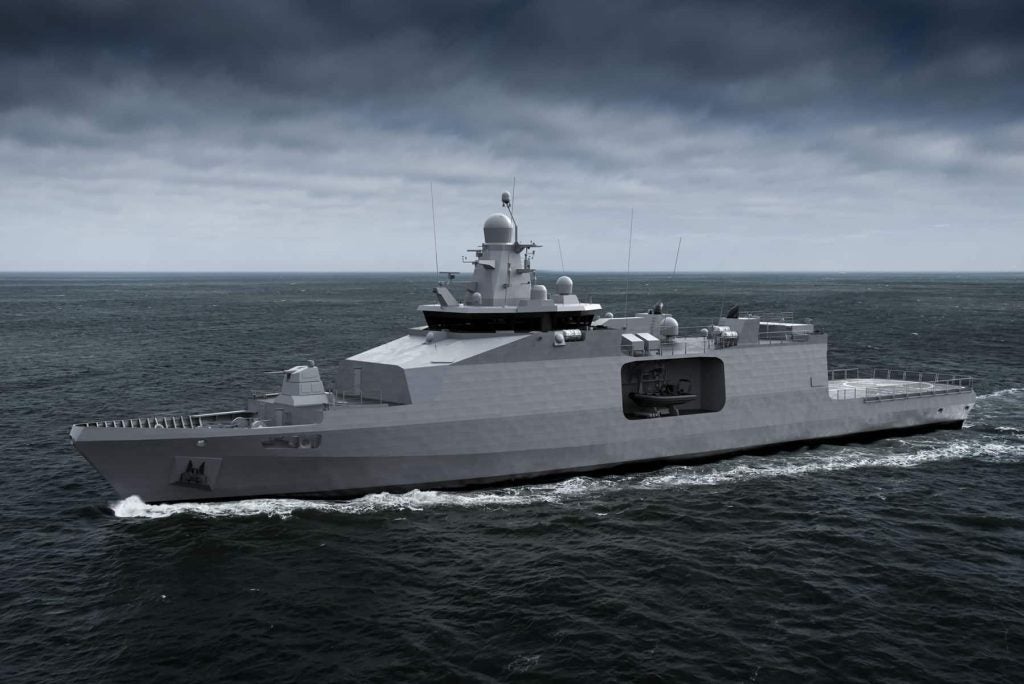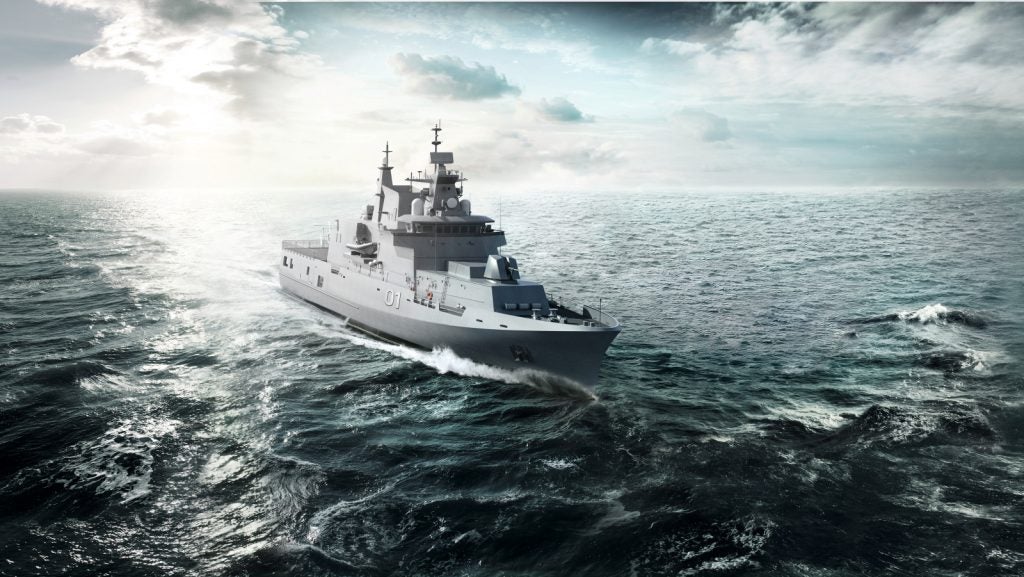
The definition of Naval ship classes can be notoriously arbitrary – for instance, two new corvettes for the Philippine Navy will be larger than its frigates, while Australia’s Hunter-class frigates will be heavier than its destroyers. Nonetheless, corvettes are typically better armed and heavier than offshore patrol vessels (OPV).
Richard Hedström, head of product management business unit Surface Ships at Saab, noted: “The corvette, due to its size and endurance, is more suitable in the littorals and in coastal operations; that is its natural habitat. But in other aspects, such as firepower and sensor capabilities, it’s just as effective and capable as a frigate.
“The great advantage with corvettes is that they give a task force commander the flexibility and freedom of action to operate in areas offshore, as well as in the protected and narrow waters of an archipelago.”
A BAE Systems spokesperson added their thoughts too, stating: “In terms of capital acquisition cost, an OPV is typically one third the price of a light frigate-sized ship, or alternatively one could have three OPVs for the price of a single light frigate.”
An OPV’s through-life cost will also be cheaper, plus it has a smaller crew. Other advantages are versatility, a smaller size which opens up a greater range of port infrastructure, and their ease of build. The BAE Systems spokesperson added: “There are not really any disadvantages of OPV-sized ships. Whilst they may not carry the combat capability of much larger ships, we would argue that is not their primary purpose.”
What of the future prospects of corvettes? Hedström assessed: “Corvettes never go out of fashion due to their high manoeuvrability, speed, firepower, and shallower draught. The corvette offers a crucial capability if you successfully want to handle the military problems that an inland sea or littoral waters imply.”
How well do you really know your competitors?
Access the most comprehensive Company Profiles on the market, powered by GlobalData. Save hours of research. Gain competitive edge.

Thank you!
Your download email will arrive shortly
Not ready to buy yet? Download a free sample
We are confident about the unique quality of our Company Profiles. However, we want you to make the most beneficial decision for your business, so we offer a free sample that you can download by submitting the below form
By GlobalDataSaab’s executive added: “Seabed warfare has established as a real threat for especially coastal states, even in peace. The future navy of any nation needs to handle all forms of threats on the spectrum, from full-scale war to peacetime operations such as surveillance of seabed infrastructure.
“Most likely, unmanned systems will support any type of naval operation. Many nations have identified this, and our Singaporean customer is one of them”, referring to Singapore’s Multi-Role Combat Vessels (MRCV) that will act as motherships for unmanned systems, besides performing more conventional capabilities such as surface warfare.

Saab supported Odense Maritime Technology with the MRCV’s basic design, while ST Engineering Marine will deliver six vessels from 2028 onwards to replace six Victory-class corvettes. Furthermore, Singapore announced in November 2023 that it had ordered four OPVs from Fassmer.
Based on a 1,890-tonne German Federal Police design, the OPVs will replace four 525-tonne Sentinel-class vessels. Highly manoeuvrable for Singapore’s congested waters, they will be fitted with both lethal and nonlethal weapons and delivered beginning in 2028.
Singapore is just one nation modernising its OPV and corvette fleets. According to sector forecasts from GlobalData, the naval vessel and surface combatant market was worth $44.2bn in 2023 and will grow at a compound annual growth rate of 4.1% to reach $65.8bn by 2033. More than 60% of the market’s value will focus on frigates, destroyers, and auxiliary vessels.
Asia-Pacific will trail only North America, and the region is expected to account for a 31.6% revenue share of the global naval vessel and surface combatant market from 2023-33. Ongoing naval modernisation initiatives to replace ageing vessels are expected to drive this regional market growth over the forecast period.
Furthermore, GlobalData forecasts state that Asia-Pacific market growth can be attributed to geopolitical tensions and maritime territorial disputes among countries such as China, India, Japan, South Korea and Taiwan.
Naval programme ambitions: industrial support
French naval prime Naval Group has been successful with corvette designs, particularly its Gowind design. A total of four 2,800-tonne corvettes were delivered to Egypt from 2017-22, three of which were built in Alexandria. Additionally, the first of two for the UAE was commissioned in November 2023.
However, Malaysia represents a cautionary tale of the risks entailed in industrial cooperation. Boustead Naval Shipyard attempted to build six Gowind 2500 corvettes in Malaysia, but the programme has been fraught with delays. Eight years after construction of the first vessel began, it is still nowhere near completion, and the Malaysian Government has already cancelled the sixth vessel.
A spokesperson from Naval Group discussed the importance of technology transfer. “All over the world, offsets, advanced technologies, indigenisation, and local content are requirements in defence procurement. Naval Group sees these requirements as an opportunity to expand its footprint with the constant aim of win-win cooperation.
“Technology transfer is a challenge for the recipient shipyard, as it must implement major changes to acquire new skills and increase its industrial capacity. The example of Malaysia demonstrates that, whatever the difficulties encountered on these complex programmes, Naval Group remains at the side of its customers and partners over the long term to provide the necessary assistance right through to completion.”

BAE Systems is another company that recognises the importance of technology transfer. Many developing countries feel able to build ships of OPV size, and shipbuilders must be ready to support such ambitions or risk losing out altogether. BAE Systems supported Thailand to build two 90.5m-long Krabi-class OPVs, for instance.
The OEM explained: “We have seen the number of OPV shipbuilding competitors increase, and clearly the abundance of supply options makes winning future export work for all shipbuilders more challenging. That is one of the reasons BAE Systems has adopted a licenced-design model for export in some regions.
“Licensed design of OPVs can be a win-win outcome for BAE Systems and its customers… shipbuilding industry gets the work and ability to further grow naval shipbuilding skills, whilst customer navies are able to draw on their own industrial base for through-life vessel support such as for repair and upgrade.”
These Thai OPVs are based on the Royal Navy’s River class, of which two have been operating in the Indo-Pacific since September 2021. HMS Spey and Tamar have visited more than two dozen countries and cumulatively travelled in excess of 120,000nm. At time of writing, one OPV had ranged as far as Pitcairn Island, halfway between New Zealand and Peru. The OPVs’ ongoing deployment is testament to their remarkable persistence.
BAE Systems told Global Defence Technology: “These deployments demonstrate the inherent reliability of these vessels, and the confidence the Royal Navy has in their ability to be supported using a combination of UK at-reach support delivered through regional partner facilities.”
Given the use case and cost benefits for the use of OPVs and corvettes, from utility, applications, and potential local industrial participation, the future of such naval vessels appears assured – a sentiment echoed by industry.
“As defence budgets around the world come under increasing pressure, OPVs are often seen as the ideal cost-effective ship type to provide essential maritime security against illegal and illicit activity. Also, with a broad range of users across navy, coast guard and border security agencies, OPVs have universal appeal,” concluded the BAE Systems spokesperson.
(This article is an abridged version of a feature due to appear in the upcoming Global Defence Technology #145, coming soon)







